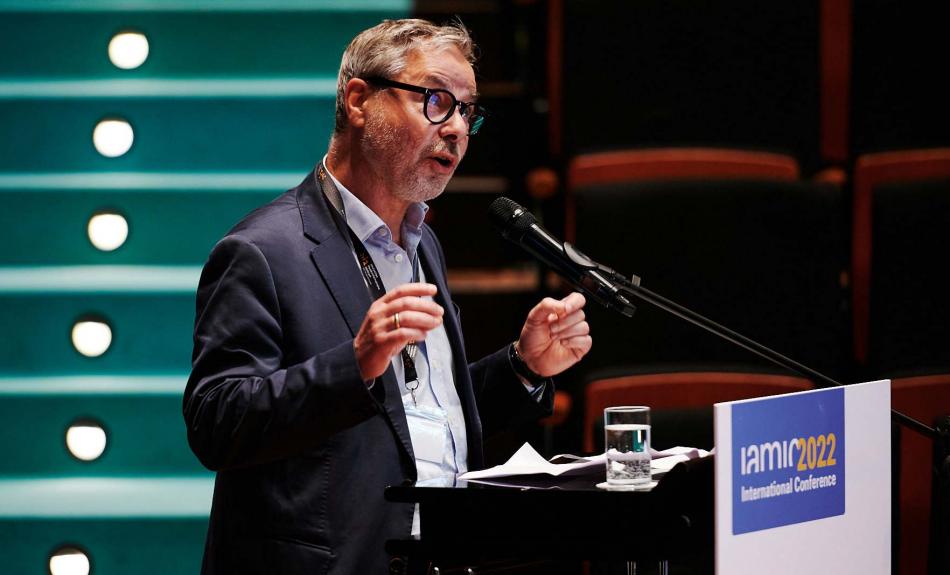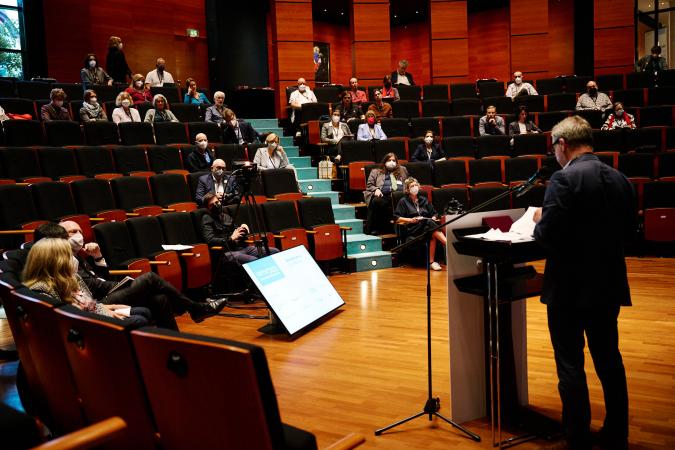Good morning, and thank you for the honour of inviting me to co-launch this day of the conference – a day which, I hope, will prove highly productive. Not to mention this location, which continues as ever to hold me spellbound, especially when I enter the room next door. This little room presumably witnessed the birth of Beethoven, the creator of music not only addressed to the whole of humanity but actually heard by large parts of it. All this from such a tiny enclosure. It beggars the imagination!
Today’s metatopic – ‘Musical Life at the intersection between tradition and future’ – is thus my topic as well. The wording is capacious enough, and the topic never actually wrong. In any event, the topic applies to me in that I, as a music journalist and a teacher of ‘Music and Media’ at Dortmund Technical University, have a lot to do with ‘tradition’ (with a focus on ‘classical’ music) at this very interface with the future. In short, I deal with what the subject of ‘Beethoven’ means, or might mean when the imperatives of tradition (e.g. the things one has to learn and master) no longer apply, or are at least called into question. The world, after all, has become more diverse and multi-voiced in every respect. All the debates on ‘preservation’ and ‘redefinition’ – on what we want to keep or discard of ‘Beethoven’ (enclosed in quotation marks to indicate its symbolic function) – are already controversial and certainly destined to become more so. My position on them is, in a nutshell, that of a media-critical intermediary: I refuse to leave Beethoven to those who think they own him. Instead, I want to break up the circle of covered wagons in which, as I see it, the ‘conservatives’ seek shelter from a residual universe currently undergoing dramatic transformation.
The massive disruptions of the covid pandemic on the music industry have already been noted, and hardly had hopes arisen of a return to a sort of normalcy than there came, terrifyingly, the perhaps still greater disruptions of war. The term ‘historical turning-point’ bulks large, and ‘normalcy’ is no longer a hope but a distant figure of yearning. We should say farewell to the idea of returning to things as they were.
In a narrower sense, my topic is the transformational dynamic that already created turmoil before the covid pandemic and the Ukraine crisis arose at all. ‘Digitalisation’ is the buzzword for an upheaval we call a revolution. To me this word, rather than being overly grand, is perfectly apt: there is every reason to assume that the consequences of digitalisation will have an even greater impact than those of, say, industrialisation. And these consequences will be as complex as the technological underpinnings themselves.
My interest falls on a specific aspect of digitalisation: namely, what does the internet do with what I wish to call (in simplified and ever-debatable form) ‘good content’. By this I mean musical art and the aesthetic experience – ‘Beethoven’ in quotes, if you will. These are things that impinge intricately, inspiringly and emotionally on our perceptive faculties. How do streaming, simultaneity, accessibility, networking and so forth alter our modes of aesthetic perception? This set of questions only seems to be a highly specific; the larger picture points to another equally large one, for its aim is the question of whether anything can counteract the well-known success logic of, say, kitty pictures in the internet. (Does this success require an explanation? The point is the empirical fact that pictures of cute kittens have a greater chance of getting clicks than a very fine recording of Beethoven’s A-minor Quartet, much less Jörg Widmann’s Jagd or an allegedly ear-opening experiment from Rebecca Saunders or Enno Poppe. Kittens, in a word, are inevitably more popular.)
After a bird’s-eye survey of the sectors of ‘good content’ – a survey I recently conducted while scouring the avalanche of the digital revolution for the preconditions of aesthetic experience – I advance the following thesis: we who are actively involved in the culture industry in a wide range of areas (production, distribution, communication), and who are concerned with music and art of the stature outlined above, have failed as yet to grasp the internet as an arena and medium of aesthetic experience. Anything and everything is downloaded en masse, but basically we are ‘digital morons’. From a mixture of overexertion, convenience and ignorance we abandon to clickbait populists and soi-disant web gurus the very field where decisions are currently being made as to what we will get to see, hear and read in the future, and where and how we can do it. There will be kitty pictures, of course. But what else?
My critique is aimed at a (perhaps intentional) ‘moronic’ approach to ‘culture’ with the possibilities of digitalisation. But it is also aimed at our perpetual willingness to rely on allegedly pat answers (faith in gurus, all-powerful algorithms and the like). And my hope is directed toward the opportunities that may reside here for the communication and reception of more complex objects. To give the message a positive twist: let us determine more exactly what it can do. Exactitude means avoiding a brain-numbing technological euphoria and scrutinising in detail what the new technological possibilities mean, not just for the aesthetic experience, but equally for the culture industry and its market.
The root system and all-powerful networking facility of digitalisation is the internet, the mightiest and most inclusive driver of change and transformation since, let us say, the invention of the steam engine. Indeed, it is far more inclusive. It clocks our everyday lives and shapes our communications, both professionally and privately. It changes everything and (nearly) everyone: media, economy, industry, education, even (subliminally) our private lives and interpersonal relations. Everything.
Faced with this indeed revolutionary transformational dynamic, the obstinacy with which many big players in the old world cling to vanishing certainties and increasingly meaningless behavioural patterns can seem remarkably escapist. Perhaps it can only be explained with the above-mentioned overexertion: it’s all they know, and whenever the pressures of change affect one’s own foundations one holds fast to what is customary, passed down, and, at one time or another, meet and proper.
„Often the budgets fall short, very often the technological expertise, and almost always the courage and imagination to perceive the digital world as something other than a threat to the existing order, but rather as what it also is, or could be: a chamber of wonders.”
I question the qualitative dimension of these possibilities, which have, in sheer quantity, already burst everything imaginable in the past. I shall proceed on the assumption that the horizon of what is possible in the new experiential spaces of the digital is, at present, only vaguely discernible. The world-wide web is capable, it is supposed, of doing so much more than it offers us at first or second glance. Why we are still so short-sighted is explicable from the structural observations outlined above: we are still in the paleo-digital age. And the old agents act on these novel platforms under the above-mentioned conditions of pressure and limitation. Often the budgets fall short, very often the technological expertise, and almost always the courage and imagination to whole-heartedly accept the new. To perceive the digital world as something other than a threat to the existing order, but rather as what it also is, or could be: a chamber of wonders. I believe that we have yet to see the best it has to offer, and that this best, with regard to the quality and enabling structure of the aesthetic experience, is perhaps not to be found primarily in its future technological potential. That imaginations run wild precisely on immersive dreams of a total audio-visual experience in the midst of an orchestra, or on the capabilities of artificial intelligence, is surely related to the extra attention already to be gained at the present moment. Extracting Beethoven’s ‘Tenth’ (to enlist the great Bonn genius one final time) from the existing sketches using high-powered computers and a little help from today’s colleagues (with something less than his artistic prowess) left me wholly unconvinced. But it was an ‘eye-catcher’, and is still being hyped on such digital channels as Magenta TV. What rubbish!
Let us turn away from sweet dreams of the future and look at the present-day impact of digitalisation. It is noticeable everywhere in the creation, production, distribution and communication of the music industry. It simplifies global exchanges and expands horizons (we will have to look at the opposing impact of the current anti-globalist trends provoked by Russia’s invasion of Ukraine). At the same time it makes questions of rights and licensing more complicated. Streaming will, of course, not replace the live analogue experience, but it will become standard as a ‘second presence’, as a simulacrum, documentation and perpetuation of one-time-only events, high in technological quality and globally visible. But what can be streamed, and where? How far can the artist’s right of disapproval escape such a presence? How far can the exclusive claims of the old majors toward their artists go when any performance anywhere leads to worldwide visibility? The traditional German label Deutsche Grammophon is currently testing limits on its ‘exclusive artists’, who, it is to be hoped, will not put up with such limits. This attempt to rescue old modes of thinking into territories and domains of the digital world is, I trust, destined to fail.
You can already guess what comes next: the future of the CD as a carrier medium does not look glorious. Audio streaming services make nearly everything available everywhere. But no lasting business model can exist at a dumping price of less than ten euros per month. Nor can artists thrive on it (there are exceptions), much less the streaming services themselves or the labels behind them. In short, the value of music must be reassessed: €9.99 for ‘everything’ is not enough for anyone.
We await with excitement the further evolution of free-of-charge musical culture in the web. As for video streaming, a proclivity toward zero price reigns supreme; every club that claims to be worthwhile, streams; each hopes for a broad impact. But if everything costs nothing and the market is inundated by cost-free visibility, this will have consequences, firstly for the quality of audio-visual products, but secondly for the range of impact. When one has, yet again, reached only 248 viewers instead of the theoretically attainable millions, and they have, on average, watched only three-and-a-half minutes of a Mahler symphony.
How to deal with superfluity is the question with which I would like to end this short early-morning tour, and I know all the things I might have brought up but didn’t: how to deal with perpetual excess; how to find the right things, to distinguish between excellence and mediocrity; how to escape the omnipotence of the algorithms that invisibly choose for us whatever conforms to their logic, a logic of marketing? I believe that a key factor in the future – even more so than content and its surrounding legal rights and exclusivity – lies in curating. By this I mean a plausible selection, based on solid expertise, of what is worth granting a moment of one’s attention. It also means making this selection accessible in a competent manner – not as a preceptive teaching programme, but with imaginative guidance. And it means accompanying ‘good content’ with friendly companionship; allowing room for complexity and being intelligently low-threshold; enabling participation and establishing a feedback culture; and much else besides. Curating as an art and, at the same time, as an instrument of quality determination, and not least as a crucial element of gate-keeping in the markets of the future, not least as a perspective for cutting-edge journalism appropriate to our times. Intelligent curators, I am convinced, will make up a good part of the future that you, of course, will now continue to debate.
I wish you much success in that endeavour, and thank you for your attention.
Professor Holger Noltze gave the keynote address at the public conference day of the annual meeting of the International Association of Music Information Centres (IAMIC) on 24 May 2022 in the Chamber Music Hall of the Beethoven-Haus Bonn. The German Music Information Centre (miz) reproduces the speech manuscript unabridged. All views expressed therein are solely those of the author.


